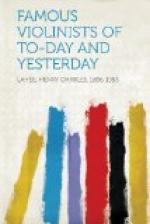Early in the eighteenth century Franz Benda was born in Bohemia at the village of Altbenatky, and Benda became the founder of a German school of violin playing. In his youth he was a chorister at Prague and afterward in the Chapel Royal at Dresden. At the same time he began to study the violin, and soon joined a company of strolling musicians who attended fetes, fairs, etc. At eighteen years of age Benda abandoned this wandering life and returned to Prague, going thence to Vienna, where he pursued his study of the violin under Graun, a pupil of Tartini. After two years he was appointed chapel master at Warsaw, and eventually he became a member of the Prince Royal of Prussia’s band, and then concert master to the king.
Benda was a master of all the difficulties of violin playing, and the rapidity of his execution and the mellow sweetness of his highest notes were unequalled. He had many pupils and wrote a number of works, chiefly exercises and studies for the violin.
A violinist whose career had a great influence on musical life in England was Johann Peter Salomon, a pupil of Benda, and it is necessary to speak of him because his name is so frequently mentioned in connection with other artists during the latter half of the eighteenth century.
Salomon was born at Bonn in the same house in which Beethoven was born, and of Salomon, after his death, Beethoven wrote: “Salomon’s death grieves me much, for he was a noble man, and I remember him ever since I was a child.”
Salomon became an expert violinist at an early age, and travelled a good deal in Europe before he settled in England, which was in 1781, when he made his appearance at Covent Garden Theatre. He was criticised thus: “He does not play in the most graceful style, it must be confessed, but his tone and execution are such as cannot fail to secure him a number of admirers in the musical world.”
He established a series of subscription concerts at the Hanover Square rooms, and produced symphonies of Mozart and Haydn. In fact, he was connected with almost every celebrity who appeared in England for many years. He was instrumental in bringing Haydn to England, and toward the end of his career he was actively interested in the foundation of the Philharmonic Society. He was noted more as a quartet player than as a soloist, and Haydn’s last quartets were composed especially to suit his style of playing. He was a man of much cultivation and moved in distinguished society. His death was caused by a fall from his horse. He was the possessor of a Stradivarius violin which was said to have belonged to Corelli and to have had his name upon it. This he bequeathed to Sir Patrick Blake of Bury St. Edmunds.
CHAPTER III.
1750 To 1800.




